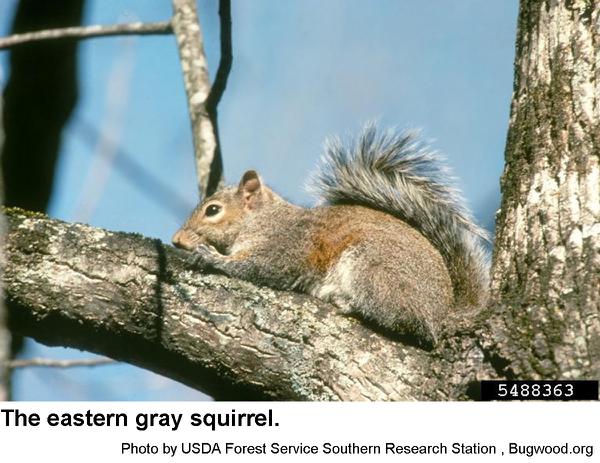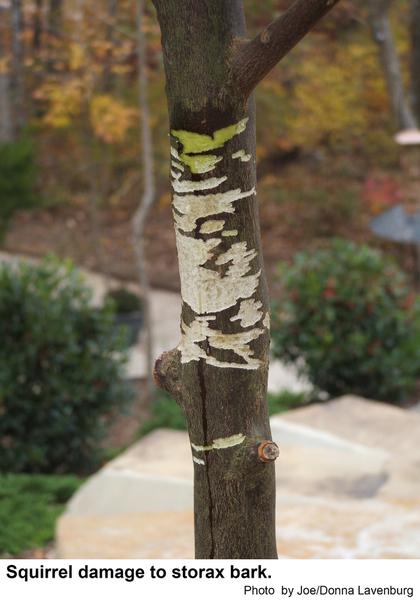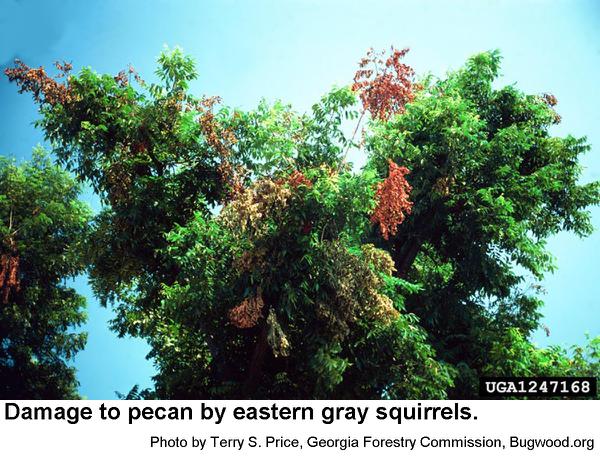Description and Biology
Eastern gray squirrels, Sciurus carolinensis, vary from black to silver gray with a white belly. They grow 16 to 24 inches from nose to tip of tail and weigh up to 24 ounces when grown. When not breeding, gray squirrels are solitary, but they may be social where there is abundant food. Although squirrels prefer to nest in cavity dens, they often construct leaf nests by making a stick frame that is then filled with dry leaves and lined with leaves, strips of bark, corn husks, or other materials. I have watched squirrels cut bushels of branches from the magnolia trees on the NC State University campus, presumably for nesting material. Survival of young is higher in dens. Gray squirrels breed in mid-winter and again in June. Forty to 45 days later females give birth to one to eight pups (usually three to four). Females have one to two litters per year. The young are weaned after two months. Gray squirrels occur in any area with sufficient supplies of nuts and seeds. In summer they also eat fruits and fungi as well as bird nestlings and insects. In winter squirrels feed on nuts, twigs, buds, and bark of trees when food is scarce. Urban yards with bird feeders are prime habitat for gray squirrels.
Host Plants
Bark damage on hollies, camellias, storax, viburnum, and other thin-barked shrubs and trees is often at least five feet off the ground (too high for rabbits and voles) with the horizontal removal of narrow, more or less parallel strips of bark. Sometimes whole patches of bark may be removed, a type of damage that can be confused with European hornet damage. However, at the edges of squirrel damage there are usually some narrow strips of missing bark. Sap suckers also remove bark, but they do it in rows of discrete holes, not narrow lines.
Residential Recommendations
Control of squirrels is a confusing issue. A common complaint about squirrels is that they often take food at feeders intended for birds. Squirrels are adept climbers and can reach almost any feeder. In addition, they frequently damage bird feeders when they enlarge openings by chewing on them or when they gnaw on perches. Trapping offending squirrels and releasing them away from the problem area or eliminating the offenders by shooting are two legal means of controlling squirrels (see DePerno in the references below). During the squirrel hunting season, trapping is permissible, but at other seasons, only shooting is allowed for squirrel control. Wire-cage traps and box traps can be used to capture squirrels alive. Prebait the traps by tying the doors open for two to three days to get squirrels accustomed to feeding in the traps. This practice will make it easier to capture a large number of squirrels in one area. Good baits are orange and apple slices, walnuts or pecans removed from the shell, and peanut butter as well as corn or sunflower seeds. After prebaiting, set the traps and check them twice daily. Although most folks find squirrels to be a nuisance, if there is interest in encouraging squirrels to nest in an area, see Moorman et al. in the References below.
References
- Animal Damage Control. DePerno, C. S. 2017. In 2021 North Carolina Agricultural Chemicals Manual.
- Eastern Gray Squirrel. Moorman, C., M. Megalos and L. Bowen. 2019 (revised). Working with Wildlife. NC State Extension Publications.
- Learn to Hunt Squirrel. Anonymous. 2014. Kentucky Department of Fish & Wildlife Resources.
- Tree Squirrels. Thurston, S. N. and M. C. Brittingham. 2013. PennState Extension. Natural Resources. Wildlife.
- NC State Extension Plant Pathology Publications
- NC State Horticultural Science Publications
For assistance with a specific problem, contact your local N.C. Cooperative Extension center.
This Factsheet has not been peer reviewed.
Publication date: April 10, 2017
Reviewed/Revised: Oct. 28, 2019
N.C. Cooperative Extension prohibits discrimination and harassment regardless of age, color, disability, family and marital status, gender identity, national origin, political beliefs, race, religion, sex (including pregnancy), sexual orientation and veteran status.




